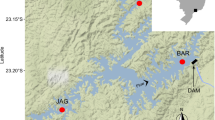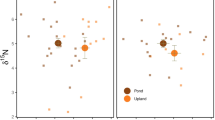Synopsis
Diet and annual production of two cyprinid fishes in the Piscataquis River, Maine, were investigated before and after extensive deforestation of the surrounding watershed. Observed patterns were evaluated relative to post-logging changes in the benthic macroinvertebrate community, and to differences in ecomorphology between the two fishes. Prey selection was generally density-dependent for both predator species throughout the study, but significant exceptions to density-dependence were observed for several aquatic insect lifemode groups (e.g., swimmers, climbers, burrowers). This apparent preference/avoidance for certain prey taxa by fish predators could be adequately explained by differential availability (vulnerability) among prey taxa. Compared to the year before logging, significant post-logging changes in diet composition and gut fullness were observed for both blacknose dace,Rhinichthys atratulus, and creek chub,Semotilus atromaculatus, concomitant with post-logging changes in the availability of benthic prey. Annual production of blacknose dace was significantly lower (52.7 vs. 37.7 kg ha−1 y−1) in the year following logging. In contrast, annual production of creek chub increased significantly after logging, from 8.6 to 17.4 kg ha−1 y−1. Because post-logging changes in the physical environment were probably not sufficient to directly affect fish populations, we hypothesize that blacknose dace were morphologically constrained to feed on a declining aquatic prey resource, with a resultant decline in production. In contrast, the generalist creek chub switched to a non-aquatic prey resource (terrestrial arthropods) and no decline in production was observed for that species.
Similar content being viewed by others
References cited
Allan, J.D. 1978. Trout predation and the size composition of stream drift. Limnol. Oceanogr. 23: 1231–1237.
Allan, J.D. 1981. Determinants of diet of brook trout in a mountain stream. Can. J. Fish. Aquat. Sci. 38: 184–192.
Anderson, H.W. 1973. The effects of clearcutting on stream temperature. A literature review. Wash. Dept. Natural Res. Rep. 29. 17 pp.
Angermeier, P.L. 1985. Spatio-temporal patterns of foraging success for fishes in an Illinois stream. Amer. Mid. Nat. 114: 342–359.
Barber, W.E. & W.L. Minckley. 1971. Summer foods of the cyprinid fishSemotilus atromaculatus. Trans. Amer. Fish. Soc. 100: 283–289.
Benke, A.C., D.M. Gillespie & F.K. Parrish. 1979. Biological basis for assessing impacts of channel modification; invertebrate production, drift, and fish feeding in a southeastern blackwater river. Report ERC 06-79, Georgia Institute of Technology, Atlanta. 85 pp.
Beschta, R.L. 1978. Long-term patterns of sediment production following road construction and logging in the Oregon Coast Range. Water Res. 14: 1011–1016.
Beschta, R.L. 1979. Debris removal and its effects on sedimentation in an Oregon Coast Range stream. Northwest Sci. 53: 71–77.
Bormann, F.H. & G.E. Likens. 1979. Pattern and process in a forested ecosystem. Springer-Verlag, New York. 253 pp.
Chesson, J. 1978. Measuring preference in selective predation. Ecology 55: 622–629.
Crowder, L.B. & W.E. Cooper. 1982. Habitat structural complexity and the interaction between bluegills and their prey. Ecology 63: 1802–1813.
Dill, L.M. 1983. Adaptive flexibility in the foraging behavior of fishes. Can. J. Fish. Aquat. Sci. 40: 398–408.
Dixon, S.M. & R.L. Baker. 1988. Effects of size on predation risk, behavioural response to fish, and cost of reduced feeding in larvalIschnura verticalis (Coenagrionidae: Odonata). Oecologia 76: 200–205.
Egglishaw, H.J. & P.E. Shackley. 1977. Growth, survival and production of juvenile salmon and trout in a Scottish stream. J. Fish. Biol. 11: 647–672.
Feller, M.C. 1981. Effects of clearcutting and slash burning on stream temperature in southwestern British Columbia. Water Res. Bull. 17: 863–867.
Fraser, D.F. & E.E. Emmons. 1984. Behavioral response of blacknose dace (Rhinichthys atratulus) to varying densities of predatory creek chub (Semotilus atromaculatus). Can. J. Fish. Aquat. Sci. 41: 364–370.
Garman, G.C. 1984. Initial effects of deforestation on aquatic community structure and function of the East Branch Piscataquis River, Maine. Ph.D. Dissertation, University of Maine, Orono. 104 pp.
Garman, G.C. 1991. Use of terrestrial arthropod prey by a stream-dwelling cyprinid fish. Env. Biol. Fish. 30: 325–331.
Garman, G.C. & J.R. Moring. 1991. Initial effects of deforestation on physical characteristics of a boreal river. Hydrobiol. 209: 29–37.
Garman, G.C. & T.F. Waters. 1983. Use of the size-frequency (Hynes) method to estimate annual production of a stream fish population. Can. J. Fish. Aquat. Sci. 40: 2030–2034.
Gibbons, D.R. & E.O. Salo. 1973. An annotated bibliography of the effects of logging on fish of the western United States and Canada. USDA For. Serv. Gen. Tech. Rep. PNW-10. 145 pp.
Gorman, O.T. & J.R. Karr. 1978. Habitat structure and stream fish communities. Ecology 59: 507–515.
Hansen, M.J. S.P. Gloss & B.L. Peckarsky. 1986. Predator species richness and prey population variability: effects on diets of benthic stream fishes. Amer. Midl. Nat. 115: 63–72.
Hunt, R.L. 1974. Annual production by brook trout in Lawrence Creek during eleven successive years. Wisc. Dept. Nat. Res. Tech. Bull. 82. 29 pp.
Hynes, H.B.N. 1970. The ecology of running waters. University of Toronto Press, Toronto. 555 pp.
Ivlev, V.W. 1961. Experimental ecology of the feeding of fishes. Yale University Press, New Haven. 302 pp.
Janssen, J. 1982. Comparison of searching behavior for zooplankton in an obligate planktivore, blueback herring (Alosa aestivalis) and a facultative planktivore, bluegill (Lepomis macrochirus). Can. J. Fish. Aquat. Sci. 39: 1649–1654.
Johnson, J.H. 1982. Summer feeding ecology of the blacknose dace,Rhinichthys atratulus, in a tributary of Lake Ontario. Can. Field Nat. 96: 282–286.
Johnson, J.H. & E.Z. Johnson. 1982. Diel foraging in relation to available prey in an Adirondack mountain stream fish community. Hydrobiol. 96: 97–104.
Karr, J.R. & I.J. Schlosser. 1978. Water resources and the land-water interface. Science 201: 229–234.
Karr, J.R., L.A. Toth & D.R. Dudley. 1985. Fish communities of midwestern rivers: a history of degradation. BioSci. 35: 90–95.
Keast, A. & D. Webb. 1966. Mouth and body form relative to feeding ecology in the fish fauna of a small lake. Lake Opinicon, Ontario. J. Fish. Res. Board Can. 23: 1845–1874.
Kingsbury, P.D. & D.P. Kreutzweiser. 1987. Permethrin treatments in Canadian forests, Part 1: impact on stream fish. Pestic. Sci. 19: 35–48.
Kohler, C.C. & J.J. Ney. 1982. A comparison of methods for quantitative analysis of feeding selection in fishes. Env. Biol. Fish. 7: 363–368.
Konkle, B.R. N.C. Collins & R.L. Baker. 1990. Use of artificial substrates to estimate prey resources available to a visually feeding benthivorous fish. Can. J. Fish. Aquat. Sci. 47: 789–793.
Kreutzweiser, D.P. 1990. Response of a brook trout (Salvelinus fontinalis) population to a reduction in stream benthos following an insecticide treatment. Can. J. Fish. Aquat. Sci. 47: 1387–1401.
Lotrich, V.A. 1973. Growth, production, and community composition of fishes inhabiting a first, second, and third-order stream of eastern Kentucky. Ecol. Monogr. 43: 377–397.
Mahon, R. & E.K. Balon. 1985. Fish production in warmwater streams in Poland and Ontario. Can. J. Fish. Aquat. Sci. 42: 1211–1215.
Mahon, R., E.K. Balon & D.L.G. Noakes. 1979. Distribution, community structure and production of fishes in the upper Speed River, Ontario: a preimpoundment study. Env. Biol. Fish. 4: 219–244.
Martin-Bergmann, K.A. & J.H. Gee. 1985. The central mudminnow,Umbra limi, a habitat specialist and resource generalist. Can. J. Zool. 63: 1753–1764.
McPeek, M.A. 1990. Behavioral differences betweenEnallagma species (Odonata) influencing differential vulnerability to predators. Ecology 71: 1714–1726.
Merritt, R.W. & K.W. Cummins (ed.).1978. An introduction to the aquatic insects of North America. Kendall/Hunt Publishing, Dubuque. 440 pp.
Meyer, A. 1989. Cost of morphological specialization: feeding performance of the two morphs in the trophically polymorphic cichlid fish,Cichlasoma citrinellum. Oecologia 80: 431–436.
Minshall, G.W., K.W. Cummins, R.C. Peterson, C.E. Cushing, D.A. Bruns, J.R. Sedell & R.L. Vannote. 1985. Developments in stream ecosystem theory. Can. J. Fish. Aquat. Sci. 42: 1045–1055.
Moring, J. & G. Garman. 1986. The value of riparian zones for fisheries. pp. 81–90. In: J.A. Bissonette (ed.) Proceedings of a Symposium, Is Good Forestry Good Wildlife Management? University of Maine, Maine Agriculture Exp. Sta., Miscel. Publ. 689.
Murphy, M.L., J. Heifetz, S.W. Johnson, K.V. Koski & J.F. Thedinga. 1986. Effects of clear-cut logging with and without buffer strips on juvenile salmonids in Alaskan streams. Can. J. Fish. Aquat. Sci. 43: 1521–1533.
Neves, R.J. 1981. Fish production in warmwater streams. pp. 356–363. In: L.A. Krumholz (ed.) Warmwater Streams Symposium, American Fisheries Society, Bethesda.
Neves, R.J. & G.B. Pardue. 1983. Abundance and production of fishes in a small Appalachian stream. Trans. Amer. Fish. Soc. 112: 21–26.
Newman, R.M. 1987. Comparison of encounter model predictions with observed size-selectivity by stream trout. J. N. Amer. Benthol. Soc. 6: 56–64.
Newman, R.M. & F.B. Martin. 1983. Estimation of fish production rates and associated variances. Can. J. Fish. Aquat. Sci. 40: 1729–1736.
Newman, R.M. & T.F. Waters. 1989. Differences in brown trout (Salmo trutta) production among contiguous sections of an entire stream. Can. J. Fish. Aquat. Sci. 46: 203–213.
Portt, C.B., E.K. Balon & D.L.G. Noakes. 1986. Biomass and production of fishes in natural and channelized streams. Can. J. Fish. Aquat. Sci. 43: 1926–1934.
Schlosser, I.J. 1982. Trophic structure, reproductive success, and growth rate of fishes in a natural and modified headwater stream. Can. J. Fish. Aquat. Sci. 39: 968–978.
Schlosser, I.J. & K.K. Ebel. 1989. Effects of flow regime and cyprinid predation on a headwater stream. Ecol. Monogr. 59: 41–57.
Schmitt, R.J. & S.J. Holbrook. 1984. Gape-limitation, foraging tactics and prey size selectivity of two microcarnivorous species of fish. Oecologia 63: 6–12.
Strauss, R.E. 1979. Reliability of Ivlev's Electivity Index, the forage ratio, and a proposed linear index of food selection. Trans. Amer. Fish. Soc. 108: 344–352.
Thedinga, J.F., M.L. Murphy, J. Heitetz, K.V. Koski & S.W. Johnson. 1989. Effects of logging on size and age composition of juvenile coho salmon (Oncorhynchus kisutch) and density of prosmolts in southeast Alaska streams. Can. J. Fish. Aquat. Sci. 46: 1383–1391.
Vannote, R.L., G.W. Minshall, K.W. Cummins, J.R. Sedell & C.E. Cushing. 1980. The river continuum concept. Can. J. Fish. Aquat. Sci. 37: 130–137.
Wainwright, P.C. 1988. Morphology and ecology: functional basis of feeding constraints in Caribbean labrid fishes. Ecology 69: 635–645.
Ware, D.M. 1973. Risk of epibenthic prey to predation by rainbow trout (Salmo gairdneri). J. Fish. Res. Board Can. 30: 787–797.
Waters, T.F. 1982. Annual production by a stream brook charr population and by its principal invertebrate food. Env. Biol. Fish. 7: 165–170.
Waters, T.F., M.T. Doherty & C.C. Kreuger. 1990. Annual production for three species of stream trout in Lake Superior tributarties. Trans. Amer. Fish. Soc. 119: 470–474.
Whitworth, W.E. & R.J. Strange. 1983. Growth and production of sympatric brook and rainbow trout in an Appalachian stream. Trans. Amer. Fish. Soc. 112: 469–474.
Wydowski, R.S. 1978. Responss of trout populations to alterations in aquatic environments: a review. pp. 57–92. In: J.R. Moring (ed.) Proc. of the Wild Trout-Catchable Trout Symposium, Oregon Dept. Fish and Wildlife, Portland.
Zippin, C. 1956. An evaluation of the removal method of estimating animal populations. Biometrics 1956: 163–189.
Author information
Authors and Affiliations
Rights and permissions
About this article
Cite this article
Garman, G.C., Moring, J.R. Diet and annual production of two boreal river fishes following clearcut logging. Environ Biol Fish 36, 301–311 (1993). https://doi.org/10.1007/BF00001726
Received:
Accepted:
Issue Date:
DOI: https://doi.org/10.1007/BF00001726




